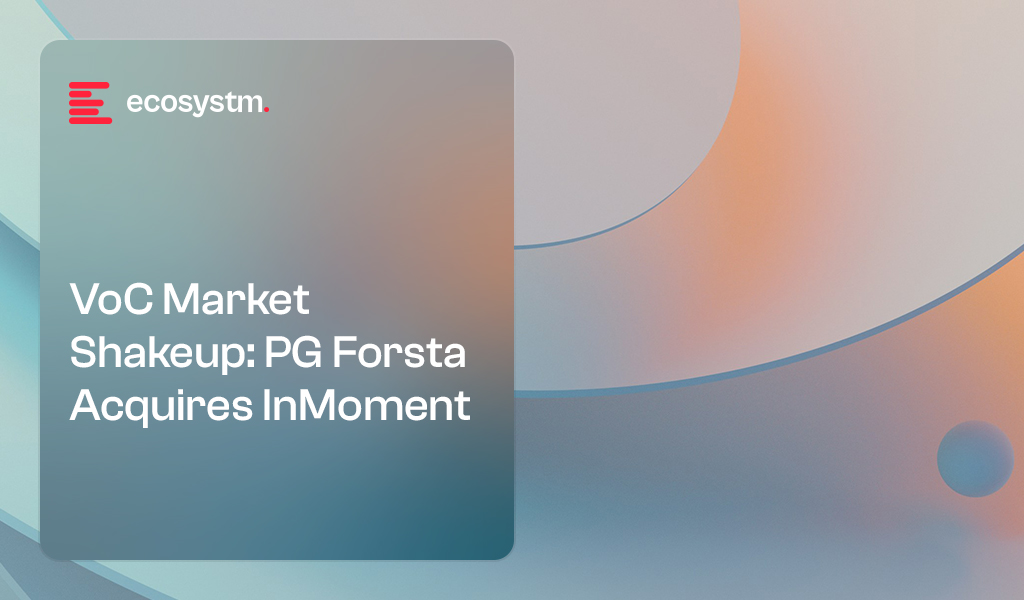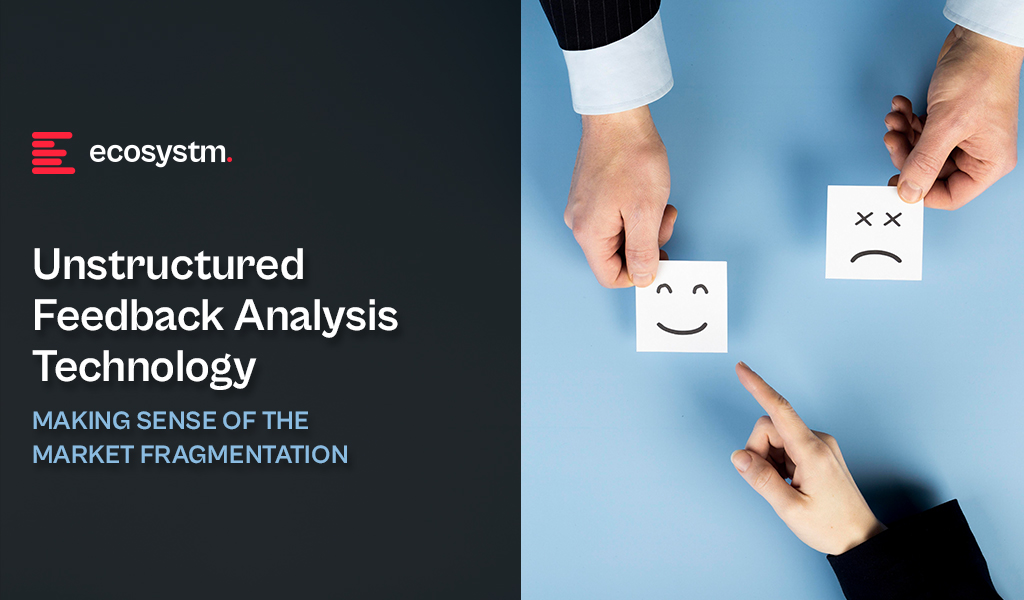The Voice of Customer (VoC) market continues to evolve, often driven by technological advancements as well as M&As. Medallia, Qualtrics, and InMoment are the three major VoC players in the enterprise segment globally and locally across ANZ.
Until recently, InMoment was the smaller contender among the three, but that changed with their acquisition by PG Forsta in May 2025. The move marks a significant shift that will alter the competitive dynamics globally and in the region.
By combining PG Forsta’s strengths in market research, structured feedback, and regulated industries with InMoment’s expertise in AI, unstructured data analysis, and its strong presence in ANZ, the newly formed entity is poised to challenge the dominance of larger rivals.
The Key Players
Medallia
Medallia is a mature player in the VoC market, with a focus on larger, more complex and ideally global programs. With ANZ, and particularly New Zealand dominated by SMB’s, the vendor is not quite as prominent locally as they are at a global level.
Medallia underwent a major executive shakeup earlier this year, bringing in a wave of leadership talent from Qualtrics, and former Clarabridge. This leadership reset brings not only strategic focus but also a significant transfer of domain expertise and IP, positioning Medallia to compete more aggressively, especially against Qualtrics.
The changes include Mark Bishof as Chairman and CEO (formerly Chief Business Officer at Qualtrics and CEO of Clarabridge), Sid Banerjee as Chief Strategy Officer (Founder of Clarabridge), and several other senior leaders.
While the vendor has been relatively quiet in the ANZ market in recent years, with renewed leadership and an internal reset, Medallia re-focuses its efforts on local customer engagement across ANZ and aims to be more active and visible in the market. For ANZ enterprises, this could bring more choice, and a potentially stronger Medallia presence in upcoming VoC initiatives.
Qualtrics
Qualtrics, another major player in the VoC market, is known for its product strength, platform developments and AI capabilities. They are the most active in terms of platform development and shared several major AI announcements earlier this year, including agentic AI capabilities.
Qualtrics also formally introduced the term Experience Management (XM) as a discipline and new software category in 2017 with the launch of the Qualtrics XM Platform and continues to dominate the conversation on XM.
Qualtrics and InMoment have dominated the local ANZ market, in the SMB to enterprise sector. Qualtrics enjoyed winning customer deals that included market research and panel requirements, since InMoment lacked that capability in-house. And that’s where PG Forsta comes in to change the dynamic.
InMoment
InMoment is a VoC technology provider known for their Experience Improvement (XI) competencies. Their strengths include conversational intelligence, reputation management, and predictive analytics. InMoment has grown by acquisition, most notably the acquisition of MaritzCX, Lexalytics, and ReviewTracker, adding online reviews and deep analytics for unstructured data to their platform.
While smaller in size than their main competitors, InMoment has a strong local presence in ANZ and thrives on their strong customer relationships.
PG Forsta Acquires InMoment: A Strategic Move
The VoC landscape, especially in ANZ, is bound to shift significantly following PG Forsta’s acquisition of InMoment. While mergers and acquisitions are common in tech, this move signals a deliberate attempt by PG Forsta and InMoment to expand their market footprint and compete more aggressively with established VoC rivals.
While PG Forsta and InMoment were both established players in the VoC market, their merger is notable not just for its scale, but for its strategic intent: to combine complementary strengths in research, analytics, and AI innovation to provide a more robust, cross-industry VoC platform.
PG Forsta, formed through Press Ganey’s 2022 acquisition of Forsta (itself a merger of Confirmit and FocusVision), offers a Human Experience (HX) platform that integrates customer, employee, and market feedback, with a strong foundation in healthcare. PG Forsta brings deep expertise in structured feedback, large-scale analytics, and regulated industries such as healthcare. InMoment, meanwhile, offers advanced capabilities in AI, machine learning, and unstructured data analysis. By combining these distinct strengths, the merged entity creates a more versatile and comprehensive solution. PG Forsta enhances their AI and omnichannel offering, while InMoment gains access to a broader, compliance-focused client base and robust market research capabilities.
The new entity will serve clients globally with a team of more than 3,000 employees. Unlike its main competitors, InMoment maintains a dedicated presence in New Zealand, bringing deep local market expertise and strong relationships. InMoment’s established footprint in ANZ further enhances PG Forsta’s local presence, providing valuable on-the-ground support that is increasingly important to organizations.
Both companies cite cultural alignment as a key factor in building a stronger, united organization, a critical foundation for any successful acquisition.
AI: The Battlefront for the Future of CX
A crucial aspect of this acquisition is its emphasis on AI. VoC platforms are evolving beyond traditional feedback collection, with growing pressure to gather data from both solicited and unsolicited sources and deliver actionable insights and recommendations. As AI capabilities become more embedded in operations, platforms are increasingly judged by their ability to go beyond static dashboards, to unify data, analyse unstructured data, and generate richer insights and proactive recommendations.
InMoment, along with some competitors, has invested in leveraging contact centre data to extract insights from unsolicited and unstructured sources through conversation intelligence. While initially used for customer insights, this technology is now expanding to serve contact centre teams and broader, organisation-wide intelligence use cases, breaking out of departmental silos.
As the market continues to prioritise outcome-driven CX, AI will be a central differentiator among leading platforms, and InMoment brings those capabilities into the PG Forsta deal.
Looking Ahead
While it’s too early to call the long-term outcome, this acquisition marks a significant shift in the VoC landscape, particularly in ANZ.
With a bold goal “to be THE VoC company in the market”, the bar is set high to deliver. The success of this acquisition will depend on execution. Seamless integration across systems, cultures, and product lines won’t happen overnight. But if they get it right, this merger could reshape the competitive landscape, raising the stakes for Medallia, Qualtrics, and others.
For CX leaders across ANZ, this brings more choice, more innovation, and better capabilities to drive deeper customer insights and business impact.

In my last Ecosystm Insights, I spoke about why organisations need to think about the Voice of the Customer (VoC) quite literally. Organisations need to listen to what their customers are telling them – not just to the survey questions they responded to, answering pre-defined questions that the organisations want to hear about.
The concept of customer feedback is evolving, and how organisations design and manage VoC programs must also change. Technology is now capable of enabling customer teams to tap into all those unsolicited, and often unstructured, raw feedback sources. Think contact centre conversations (calls, chats, chatbots, emails, complaints, call notes), CRM notes, online reviews, social media, etc. Those are all sources of raw customer feedback, waiting to be converted into customer insights.
Organisations can now find the capability of extracting customer insight from raw data across a wide range of solutions, from VoC platforms, data management platforms, contact centre solutions, text analytics players, etc. The expanding tech ecosystem presents opportunities for organisations to enhance their programs. However, navigating this breadth of options can also be confusing as they strive to identify the most suitable tools for their requirements.
As CX programs mature and shift from survey feedback to truly listening to customers, the demand for tech solutions tailored to various needs increases.
Where are tech vendors headed?
As part of my job as CX Consultant & Tech Advisor, I spend a lot of time working with my clients. But I also spend a lot of time speaking with technology vendors, who provide the solutions my clients need. Over the last few weeks and months there’s been a flurry of activity across the CX technology market with lots of product announcements around one specific topic. You guessed it, GenAI.
So, I invested some time in finding out how tech vendors are evolving their offerings. From Medallia, InMoment, Thematic, LiquidVoice, Concentrix, Snowflake, Nice, to Tethr – a broad variety of different vendors, but all with one thing in common; they help analyse customer feedback data.
And I like what I hear. The conversation has not been about GenAI because of GenAI, but about use cases and real-life applications for CX practitioners, including Insights & Research team, Contact Centre, CX, VoC, Digital teams, and so on. The list is long when we include everyone who has a role to play in creating, maintaining, and improving customer experiences.
It’s no wonder that many different vendors have started to embed those capabilities into their solutions and launch new products or features. The tech landscape is becoming increasingly fragmented at this stage.
What are an organisation’s tech options?
- The traditional VoC platform providers typically offer some text analytics capabilities (although not always included in the base price) and have started to tap into the contact centre solutions as well. Some also offer some social media or online review analysis, leaving organisations with a relatively good understanding of customer sentiment and a better understanding of their CX.
- Contact centre solutions are traditionally focused on analysing calls for Quality Assurance (QA) purposes and use surveys for agent coaching. Many contact centre players have evolved their portfolios to include text analytics or conversational intelligence to extract broader customer insights. Although at this stage they’re not always shared with the rest of the organisation (one step at a time…).
- Conversational analytics/intelligence providers have emerged over the last few years and are a powerhouse for contact centre and chatbot conversations. The contact centre really is the treasure trove of customer insights, although vastly underutilised for it so far!
- CRMs are the backbone of the customer experience management toolkit as they hold a vast amount of metadata. They’ve also been able to send surveys for a while now. Analysing unstructured data however (whether survey verbatim or otherwise) isn’t one of their strengths. This leaves organisations with a lot of data but not necessarily insights.
- Social media listening tools are often standalone tools used by the social media teams. There are not many instances of them being used for the analysis of other unstructured feedback.
- Digital/website feedback tools, in line with some of the above, are centred around collecting feedback, not necessarily analysing the unstructured feedback.
- Pure text analytics players are traditionally focused on analysing surveys verbatim. As this is their core offering, they tend to be proficient in it and have started to broaden their portfolios to include other unstructured feedback sources.
- Customer Data Platforms (CDP)/ Data Management Platforms (DMP) are more focused on quantitative data about customers and their experiences. Although many speak about their ability to analyse unstructured feedback as well, it doesn’t appear to be their strengths.
Conclusion
But what does that leave organisations with? Apart from very confused tech users trying to find the right solution for their organisation.
At this stage, there is immense market fragmentation, with many vendors from different core capabilities starting to incorporate capabilities to analyse unstructured data in the wake of the GenAI boom. However, a market convergence is expected.
While we watch how the market unfolds, one thing is certain. Organisations and customer teams will need to adjust – and that includes the tech stack as well as the CX program set up. With customer feedback now coming from anywhere within or outside the organisation, there is a need for a consolidated source of truth to make sense of it all and move from raw data to customer insights. While organisations will benefit immensely from a consolidated customer data repository, it’s also crucial to break down organisational silos at the same time and democratise insights as widely as possible to enable informed decision-making.




